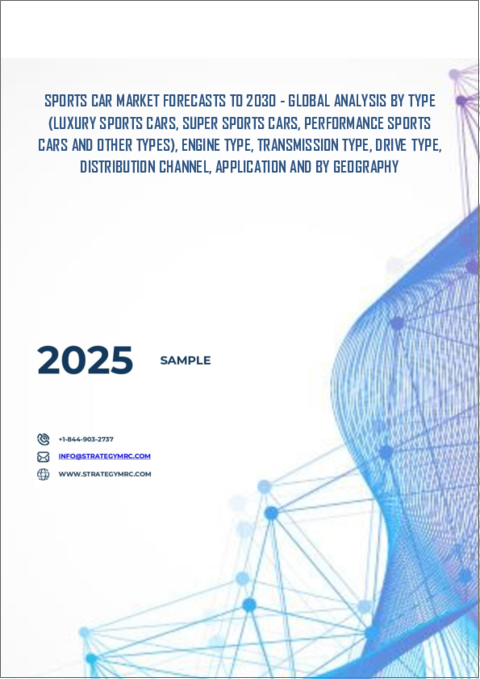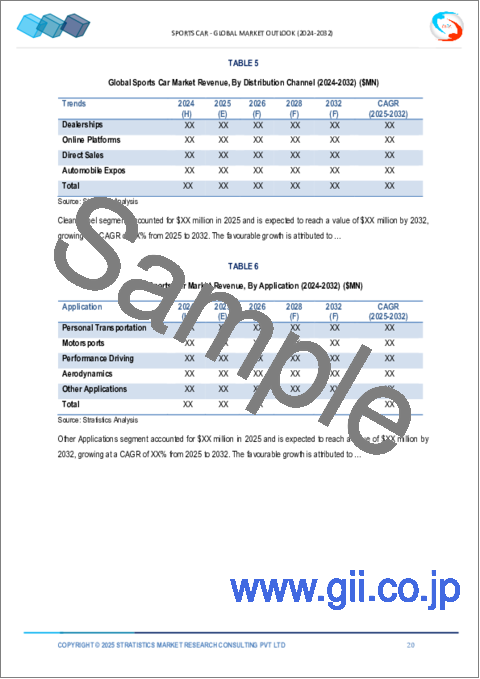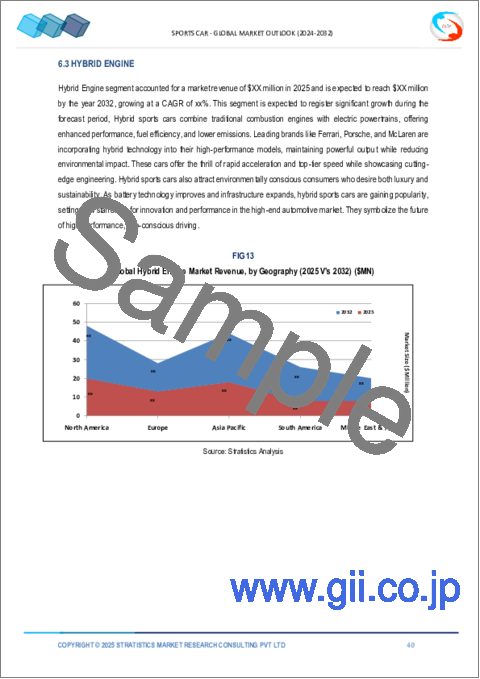|
|
市場調査レポート
商品コード
1530776
スポーツカーの2030年までの市場予測: タイプ別、エンジンタイプ別、トランスミッションタイプ別、ドライブタイプ別、流通チャネル別、用途別、地域別の世界分析Sports Car Market Forecasts to 2030 - Global Analysis By Type (Luxury Sports Cars, Super Sports Cars, Performance Sports Cars and Other Types), Engine Type, Transmission Type, Drive Type, Distribution Channel, Application and By Geography |
||||||
カスタマイズ可能
|
|||||||
| スポーツカーの2030年までの市場予測: タイプ別、エンジンタイプ別、トランスミッションタイプ別、ドライブタイプ別、流通チャネル別、用途別、地域別の世界分析 |
|
出版日: 2024年08月01日
発行: Stratistics Market Research Consulting
ページ情報: 英文 200+ Pages
納期: 2~3営業日
|
全表示
- 概要
- 図表
- 目次
Stratistics MRCによると、世界のスポーツカー市場は2024年に1,180億米ドルを占め、予測期間中のCAGRは4.5%で成長し、2030年には1,537億米ドルに達する見込みです。
スポーツカーは、ダイナミックなドライビングを楽しむために設計された高性能車です。一般的に、低く空力的なプロファイル、強力なエンジン、機敏なハンドリングを特徴とするスポーツカーは、スピード、正確さ、 促進要因の関与を優先します。多くの場合、2ドアレイアウト、軽量構造、応答性を高める先進のサスペンションシステムを特徴としています。洗練された美しさで知られる一方で、スポーツカーは爽快な加速とコーナリング性能を提供することを目指しており、運転愛好家や、より高度な運転体験を求める人々に人気があります。
女性購買層の増加
消費者の嗜好が進化し、スタイルとパフォーマンスが重視されるようになったことで、市場では女性購入者が大幅に増加しています。女性は、その美しさだけでなく、先進的な機能や運転体験からも、スポーツカーにますます惹かれるようになっています。この変化は、女性をターゲットにしたメッセージやデザインを提供するマーケティング戦略に反映されています。自動車業界が多様性を受け入れ続ける中、女性購買層の増加は市場動向や製品開発にさらに影響を与えると予想されます。
排ガス規制の強化
排ガス規制の強化は市場における重要な課題であり、メーカーは汚染物質を削減しながらエンジンの設計と性能を革新する必要に迫られています。こうした規制は、電気自動車やハイブリッド・パワートレインなど、よりクリーンな技術の開発を促すものであり、従来の高性能スポーツカーの魅力を変える可能性があります。規制の遵守と、スポーツカー愛好家が期待する爽快なドライビング体験の維持のバランスをとるには、多額の投資と技術の進歩が必要です。
運転体験への情熱
市場におけるドライビングへの情熱は、爽快なパフォーマンスと精密さへの強い欲求によって駆り立てられています。エンスージアストは、比類のない加速、反応の良いハンドリング、そして 促進要因とマシンの間の直感的なつながりを実現する車を求めています。スポーツカーは、その洗練されたデザインと高速性能で賞賛され、オープンロードのスリルを重視する人々に支持されています。この熱狂は需要を喚起するだけでなく、自動車工学の革新を促し、卓越したドライビング体験を生み出しています。
電気自動車へのシフト
電気自動車(EV)へのシフトは、市場に大きな課題をもたらしています。伝統的なスポーツカーは、そのパワフルな内燃エンジンと高速性能で称賛されているが、現在のEV技術ではこれを再現することは難しいです。メーカーは、ユニークなドライビング・エクスペリエンスを維持しながら、同等かそれ以上のパフォーマンス・レベルを提供するためにイノベーションを起こさなければならないです。さらに、先進EV技術の高コストとバッテリーの限界は、手頃な価格と市場導入に影響する可能性があります。
COVID-19の影響:
COVID-19の流行は、製造およびサプライ・チェーンに混乱を引き起こし、生産の遅れや部品の入手可能性の低下を招き、スポーツカー市場に大きな影響を与えました。また、ロックダウンや社会的距離を置く措置により、スポーツカーを含む高級品への消費支出が減少しました。景気の不透明感や優先順位の変化により、市場は販売台数の減少に見舞われました。しかし、緩やかな回復と高性能車やプレミアム車への関心の高まりが、この分野の回復を後押ししています。
予測期間中、スーパースポーツカー部門が最大となる見込み
予測期間中、スーパースポーツカーが最大となる見込みです。多くの場合、高級ブランドによって生産されるこれらの自動車は、最先端技術、空力設計、強力なエンジンを特徴とし、優れた加速とハンドリングを実現します。これらの自動車は、極限のドライビング体験と高級感を求めるエンスージアストに応えるものです。高価格帯で生産台数が限られているため、自動車の革新性と性能の限界を押し広げるフラッグシップ・モデルとしての役割を果たすことが多いです。
予測期間中、モータースポーツ分野のCAGRが最も高くなると予想されます。
モータースポーツ分野は、技術革新とブランドの名声向上を牽引し、予測期間中に最も高いCAGRを示すと予想されます。知名度の高いレースイベントは、メーカーが過酷な条件下で先進技術を披露し、テストするためのプラットフォームとして機能します。こうした競争は自動車工学の限界を押し広げるだけでなく、消費者の嗜好や業界の動向にも大きな影響を与えます。モータースポーツにおける名声と成功は、ブランドイメージを高め、このセグメントの売上を牽引します。
最大のシェアを占める地域:
予測期間中、北米が最大の市場シェアを占めると予測されます。先進技術、優れた運転体験、スタイリッシュなデザインを求める愛好家が市場を牽引しています。主要セグメントには、エントリーレベルのスポーツカーとハイエンドのスーパーカーが含まれ、電動スポーツモデルへの関心が高まっています。フォード、シボレー、ポルシェといった大手企業が市場を席巻しています。市場の成長を支えているのは、可処分所得の増加、技術の進歩、高速で革新的な運転体験を求める動向です。
CAGRが最も高い地域:
アジア太平洋地域は、可処分所得の増加、富裕層の増加、高性能車への情熱の高まりにより、予測期間中最も高いCAGRを維持すると予測されます。先進技術、性能、高級機能への嗜好が高まっています。ハイブリッド車や電動スポーツカーも人気を集めています。電動スポーツカーには成長機会があり、アジア市場特有の嗜好に応えるカスタマイズ・オプションも増えています。
無料カスタマイズの提供:
本レポートをご購読のお客様には、以下の無料カスタマイズオプションのいずれかをご提供いたします:
- 企業プロファイル
- 追加市場プレイヤーの包括的プロファイリング(3社まで)
- 主要企業のSWOT分析(3社まで)
- 地域セグメンテーション
- 顧客の関心に応じた主要国の市場推計・予測・CAGR(注:フィージビリティチェックによる)
- 競合ベンチマーキング
- 製品ポートフォリオ、地理的プレゼンス、戦略的提携に基づく主要企業のベンチマーキング
目次
第1章 エグゼクティブサマリー
第2章 序文
- 概要
- ステークホルダー
- 調査範囲
- 調査手法
- データマイニング
- データ分析
- データ検証
- 調査アプローチ
- 調査情報源
- 1次調査情報源
- 2次調査情報源
- 前提条件
第3章 市場動向分析
- 促進要因
- 抑制要因
- 機会主義
- 脅威
- 用途分析
- 新興市場
- COVID-19の影響
第4章 ポーターのファイブフォース分析
- 供給企業の交渉力
- 買い手の交渉力
- 代替品の脅威
- 新規参入業者の脅威
- 競争企業間の敵対関係
第5章 世界のスポーツカー市場:タイプ別
- 高級スポーツカー
- スーパースポーツカー
- 高性能スポーツカー
- その他のタイプ
第6章 世界のスポーツカー市場:エンジンタイプ別
- 内燃機関(ICE)
- ハイブリッドエンジン
- 電動モーター
第7章 世界のスポーツカー市場:トランスミッションタイプ別
- マニュアルトランスミッション
- オートマチックトランスミッション
- セミオートマチックトランスミッション
第8章 世界のスポーツカー市場:ドライブタイプ別
- 後輪駆動(RWD)
- 前輪駆動(FWD)
- 全輪駆動(AWD)
第9章 世界のスポーツカー市場:流通チャネル別
- ディーラー
- オンラインプラットフォーム
- 直接販売
- 自動車エキスポ
第10章 世界のスポーツカー市場:用途別
- 個人輸送
- モータースポーツ
- パフォーマンスドライビング
- 空気力学
- その他の用途
第11章 世界のスポーツカー市場:地域別
- 北米
- 米国
- カナダ
- メキシコ
- 欧州
- ドイツ
- 英国
- イタリア
- フランス
- スペイン
- その他欧州
- アジア太平洋
- 日本
- 中国
- インド
- オーストラリア
- ニュージーランド
- 韓国
- その他アジア太平洋地域
- 南米
- アルゼンチン
- ブラジル
- チリ
- その他南米
- 中東・アフリカ
- サウジアラビア
- アラブ首長国連邦
- カタール
- 南アフリカ
- その他中東とアフリカ
第12章 主な発展
- 契約、パートナーシップ、コラボレーション、合弁事業
- 買収と合併
- 新製品発売
- 事業拡大
- その他の主要戦略
第13章 企業プロファイリング
- Ferrari N.V.
- Porsche AG
- Lamborghini S.p.A.
- Bugatti Automobiles S.A.S.
- Jaguar Land Rover Automotive plc
- Maserati S.p.A.
- BMW AG
- Mercedes-Benz Group AG
- Audi AG
- Chevrolet
- Ford Motor Company
- Nissan Motor Corporation
- Subaru Corporation
- Toyota Motor Corporation
- Honda Motor Co., Ltd.
- Tesla, Inc.
- Lucid Motors, Inc.
- Morgan Motor Company Ltd.
List of Tables
- Table 1 Global Sports Car Market Outlook, By Region (2022-2030) ($MN)
- Table 2 Global Sports Car Market Outlook, By Type (2022-2030) ($MN)
- Table 3 Global Sports Car Market Outlook, By Luxury Sports Cars (2022-2030) ($MN)
- Table 4 Global Sports Car Market Outlook, By Super Sports Cars (2022-2030) ($MN)
- Table 5 Global Sports Car Market Outlook, By Performance Sports Cars (2022-2030) ($MN)
- Table 6 Global Sports Car Market Outlook, By Other Types (2022-2030) ($MN)
- Table 7 Global Sports Car Market Outlook, By Engine Type (2022-2030) ($MN)
- Table 8 Global Sports Car Market Outlook, By Internal Combustion Engine (ICE) (2022-2030) ($MN)
- Table 9 Global Sports Car Market Outlook, By Hybrid Engine (2022-2030) ($MN)
- Table 10 Global Sports Car Market Outlook, By Electric Motor (2022-2030) ($MN)
- Table 11 Global Sports Car Market Outlook, By Transmission Type (2022-2030) ($MN)
- Table 12 Global Sports Car Market Outlook, By Manual Transmission (2022-2030) ($MN)
- Table 13 Global Sports Car Market Outlook, By Automatic Transmission (2022-2030) ($MN)
- Table 14 Global Sports Car Market Outlook, By Semi-Automatic Transmission (2022-2030) ($MN)
- Table 15 Global Sports Car Market Outlook, By Drive Type (2022-2030) ($MN)
- Table 16 Global Sports Car Market Outlook, By Rear-Wheel Drive (RWD) (2022-2030) ($MN)
- Table 17 Global Sports Car Market Outlook, By Front-Wheel Drive (FWD) (2022-2030) ($MN)
- Table 18 Global Sports Car Market Outlook, By All-Wheel Drive (AWD) (2022-2030) ($MN)
- Table 19 Global Sports Car Market Outlook, By Distribution Channel (2022-2030) ($MN)
- Table 20 Global Sports Car Market Outlook, By Dealerships (2022-2030) ($MN)
- Table 21 Global Sports Car Market Outlook, By Online Platforms (2022-2030) ($MN)
- Table 22 Global Sports Car Market Outlook, By Direct Sales (2022-2030) ($MN)
- Table 23 Global Sports Car Market Outlook, By Automobile Expos (2022-2030) ($MN)
- Table 24 Global Sports Car Market Outlook, By Application (2022-2030) ($MN)
- Table 25 Global Sports Car Market Outlook, By Personal Transportation (2022-2030) ($MN)
- Table 26 Global Sports Car Market Outlook, By Motorsports (2022-2030) ($MN)
- Table 27 Global Sports Car Market Outlook, By Performance Driving (2022-2030) ($MN)
- Table 28 Global Sports Car Market Outlook, By Aerodynamics (2022-2030) ($MN)
- Table 29 Global Sports Car Market Outlook, By Other Applications (2022-2030) ($MN)
Note: Tables for North America, Europe, APAC, South America, and Middle East & Africa Regions are also represented in the same manner as above.
According to Stratistics MRC, the Global Sports Car Market is accounted for $118.0 billion in 2024 and is expected to reach $153.7 billion by 2030 growing at a CAGR of 4.5% during the forecast period. A sports car is a high-performance vehicle designed for dynamic driving experiences. Typically characterized by a low, aerodynamic profile, a powerful engine, and agile handling, sports cars prioritize speed, precision, and driver engagement. They often feature a two-door layout, lightweight construction, and advanced suspension systems to enhance responsiveness. While known for their sleek aesthetics, sports cars aim to deliver exhilarating acceleration and cornering capabilities, making them popular among driving enthusiasts and those seeking an elevated driving experience.
Market Dynamics:
Driver:
Growing female buyer base
The market is witnessing a significant increase in female buyers, driven by evolving consumer preferences and greater emphasis on style and performance. Women are increasingly drawn to sports cars not only for their aesthetics but also for their advanced features and driving experience. This shift is reflected in marketing strategies that target women with tailored messages and designs. As the automotive industry continues to embrace diversity, the growing female buyer base is expected to further influence market trends and product development.
Restraint:
Stricter emission regulations
Stricter emission regulations are a significant challenge in the market, compelling manufacturers to innovate in engine design and performance while reducing pollutants. These regulations push for the development of cleaner technologies, such as electric or hybrid powertrains, which can alter the traditional appeal of high-performance sports cars. Balancing regulatory compliance with maintaining the exhilarating driving experience sports car enthusiasts expect requires substantial investment and technological advancements.
Opportunity:
Passion for driving experience
The passion for driving in the market is driven by an intense desire for exhilarating performance and precision. Enthusiasts seek vehicles that deliver unmatched acceleration, responsive handling, and a visceral connection between driver and machine. Sports cars are celebrated for their sleek designs and high-speed capabilities, catering to those who value the thrill of the open road. This fervor not only fuels demand but also drives innovation in automotive engineering, creating exceptional driving experiences.
Threat:
Shift towards electric vehicles
The shift towards electric vehicles (EVs) presents a significant challenge in the market. Traditional sports cars are celebrated for their powerful internal combustion engines and high-speed performance, which are difficult to replicate with current EV technology. Manufacturers must innovate to deliver similar or superior performance levels while maintaining the unique driving experience. Additionally, the high cost of advanced EV technologies and battery limitations can affect affordability and market adoption.
Covid-19 Impact:
The COVID-19 pandemic significantly impacted the sports car market by causing disruptions in manufacturing and supply chains, resulting in production delays and reduced availability of components. Lockdowns and social distancing measures also led to decreased consumer spending on luxury items, including sports cars. The market experienced a decline in sales due to economic uncertainty and shifting priorities. However, the gradual recovery and increased interest in high-performance and premium vehicles are driving a rebound in the sector.
The super sports cars segment is expected to be the largest during the forecast period
The super sports cars is expected to be the largest during the forecast period. These vehicles, often produced by luxury brands, feature cutting-edge technology, aerodynamic designs, and powerful engines deliver superior acceleration and handling. They cater to enthusiasts seeking extreme driving experiences and exclusivity. With their high price points and limited production runs, they often serve as flagship models that push the boundaries of automotive innovation and performance.
The motorsports segment is expected to have the highest CAGR during the forecast period
The motorsports segment is expected to have the highest CAGR during the forecast period driving technological innovation and enhancing brand prestige. High-profile racing events serve as platforms for manufacturers to showcase and test advanced technologies under extreme conditions. These competitions not only push the boundaries of automotive engineering but also significantly influence consumer preferences and industry trends. The prestige and success in motorsports bolster brand image and drive sales in the segment.
Region with largest share:
North America is projected to hold the largest market share during the forecast period. The market is driven by enthusiasts seeking advanced technology, superior driving experience, and stylish design. Key segments include entry-level sports cars and high-end supercars, with increasing interest in electric sports models. Major players like Ford, Chevrolet, and Porsche dominate the landscape. The market's growth is supported by rising disposable incomes, technological advancements, and a trend toward high-speed, innovative driving experiences.
Region with highest CAGR:
Asia Pacific is projected to hold the highest CAGR over the forecast period due to increasing disposable incomes, a rising number of affluent individuals, and a growing passion for high-performance cars. There's a growing preference for advanced technology, performance, and luxury features. Hybrid and electric sports cars are also gaining traction. There is an opportunity for growth in electric sports cars and increased customization options to cater to the specific tastes of the Asian market.
Key players in the market
Some of the key players in Sports Car market include Ferrari N.V., Porsche AG, Lamborghini S.p.A., Bugatti Automobiles S.A.S.,, Jaguar Land Rover Automotive plc, Maserati S.p.A., BMW AG, Mercedes-Benz Group AG, Audi AG, Chevrolet, Ford Motor Company, Nissan Motor Corporation, Subaru Corporation, Toyota Motor Corporation, Honda Motor Co., Ltd., Tesla, Inc., Lucid Motors, Inc. and Morgan Motor Company Ltd.
Key Developments:
In May 2024, Ferrari NV has unveiled a €395,000 ($423,000) combustion engine sports car meant to help the Italian manufacturer defend its industry-leading margins. The 12Cilindri, also sold as a €435,000 Spider convertible version, is inspired by Ferrari's touring cars from the 1960s and represents a fresh option amid several sold-outs.
In January 2024, Lamborghini S.p.A. and Zynga Inc. announced a multi-year agreement to make CSR Racing (CSR), the hyper-real mobile racing franchise of Zynga's subsidiary NaturalMotion, an official partner of Lamborghini's new LMDH prototype entry in the FIA WEC Hypercar Class and IMSA Grand Touring Prototype (GTP) Class global racing championships.
Types Covered:
- Luxury Sports Cars
- Super Sports Cars
- Performance Sports Cars
- Other Types
Engine Types Covered:
- Internal Combustion Engine (ICE)
- Hybrid Engine
- Electric Motor
Transmission Types Covered:
- Manual Transmission
- Automatic Transmission
- Semi-Automatic Transmission
Drive Types Covered:
- Rear-Wheel Drive (RWD)
- Front-Wheel Drive (FWD)
- All-Wheel Drive (AWD)
Distribution Channels Covered:
- Dealerships
- Online Platforms
- Direct Sales
- Automobile Expos
Applications Covered:
- Personal Transportation
- Motorsports
- Performance Driving
- Aerodynamics
- Other Applications
Regions Covered:
- North America
- US
- Canada
- Mexico
- Europe
- Germany
- UK
- Italy
- France
- Spain
- Rest of Europe
- Asia Pacific
- Japan
- China
- India
- Australia
- New Zealand
- South Korea
- Rest of Asia Pacific
- South America
- Argentina
- Brazil
- Chile
- Rest of South America
- Middle East & Africa
- Saudi Arabia
- UAE
- Qatar
- South Africa
- Rest of Middle East & Africa
What our report offers:
- Market share assessments for the regional and country-level segments
- Strategic recommendations for the new entrants
- Covers Market data for the years 2022, 2023, 2024, 2026, and 2030
- Market Trends (Drivers, Constraints, Opportunities, Threats, Challenges, Investment Opportunities, and recommendations)
- Strategic recommendations in key business segments based on the market estimations
- Competitive landscaping mapping the key common trends
- Company profiling with detailed strategies, financials, and recent developments
- Supply chain trends mapping the latest technological advancements
Free Customization Offerings:
All the customers of this report will be entitled to receive one of the following free customization options:
- Company Profiling
- Comprehensive profiling of additional market players (up to 3)
- SWOT Analysis of key players (up to 3)
- Regional Segmentation
- Market estimations, Forecasts and CAGR of any prominent country as per the client's interest (Note: Depends on feasibility check)
- Competitive Benchmarking
- Benchmarking of key players based on product portfolio, geographical presence, and strategic alliances
Table of Contents
1 Executive Summary
2 Preface
- 2.1 Abstract
- 2.2 Stake Holders
- 2.3 Research Scope
- 2.4 Research Methodology
- 2.4.1 Data Mining
- 2.4.2 Data Analysis
- 2.4.3 Data Validation
- 2.4.4 Research Approach
- 2.5 Research Sources
- 2.5.1 Primary Research Sources
- 2.5.2 Secondary Research Sources
- 2.5.3 Assumptions
3 Market Trend Analysis
- 3.1 Introduction
- 3.2 Drivers
- 3.3 Restraints
- 3.4 Opportunitis
- 3.5 Threats
- 3.6 Application Analysis
- 3.7 Emerging Markets
- 3.8 Impact of Covid-19
4 Porters Five Force Analysis
- 4.1 Bargaining power of suppliers
- 4.2 Bargaining power of buyers
- 4.3 Threat of substitutes
- 4.4 Threat of new entrants
- 4.5 Competitive rivalry
5 Global Sports Car Market, By Type
- 5.1 Introduction
- 5.2 Luxury Sports Cars
- 5.3 Super Sports Cars
- 5.4 Performance Sports Cars
- 5.5 Other Types
6 Global Sports Car Market, By Engine Type
- 6.1 Introduction
- 6.2 Internal Combustion Engine (ICE)
- 6.3 Hybrid Engine
- 6.4 Electric Motor
7 Global Sports Car Market, By Transmission Type
- 7.1 Introduction
- 7.2 Manual Transmission
- 7.3 Automatic Transmission
- 7.4 Semi-Automatic Transmission
8 Global Sports Car Market, By Drive Type
- 8.1 Introduction
- 8.2 Rear-Wheel Drive (RWD)
- 8.3 Front-Wheel Drive (FWD)
- 8.4 All-Wheel Drive (AWD)
9 Global Sports Car Market, By Distribution Channel
- 9.1 Introduction
- 9.2 Dealerships
- 9.3 Online Platforms
- 9.4 Direct Sales
- 9.5 Automobile Expos
10 Global Sports Car Market, By Application
- 10.1 Introduction
- 10.2 Personal Transportation
- 10.3 Motorsports
- 10.4 Performance Driving
- 10.5 Aerodynamics
- 10.6 Other Applications
11 Global Sports Car Market, By Geography
- 11.1 Introduction
- 11.2 North America
- 11.2.1 US
- 11.2.2 Canada
- 11.2.3 Mexico
- 11.3 Europe
- 11.3.1 Germany
- 11.3.2 UK
- 11.3.3 Italy
- 11.3.4 France
- 11.3.5 Spain
- 11.3.6 Rest of Europe
- 11.4 Asia Pacific
- 11.4.1 Japan
- 11.4.2 China
- 11.4.3 India
- 11.4.4 Australia
- 11.4.5 New Zealand
- 11.4.6 South Korea
- 11.4.7 Rest of Asia Pacific
- 11.5 South America
- 11.5.1 Argentina
- 11.5.2 Brazil
- 11.5.3 Chile
- 11.5.4 Rest of South America
- 11.6 Middle East & Africa
- 11.6.1 Saudi Arabia
- 11.6.2 UAE
- 11.6.3 Qatar
- 11.6.4 South Africa
- 11.6.5 Rest of Middle East & Africa
12 Key Developments
- 12.1 Agreements, Partnerships, Collaborations and Joint Ventures
- 12.2 Acquisitions & Mergers
- 12.3 New Product Launch
- 12.4 Expansions
- 12.5 Other Key Strategies
13 Company Profiling
- 13.1 Ferrari N.V.
- 13.2 Porsche AG
- 13.3 Lamborghini S.p.A.
- 13.4 Bugatti Automobiles S.A.S.
- 13.5 Jaguar Land Rover Automotive plc
- 13.6 Maserati S.p.A.
- 13.7 BMW AG
- 13.8 Mercedes-Benz Group AG
- 13.9 Audi AG
- 13.10 Chevrolet
- 13.11 Ford Motor Company
- 13.12 Nissan Motor Corporation
- 13.13 Subaru Corporation
- 13.14 Toyota Motor Corporation
- 13.15 Honda Motor Co., Ltd.
- 13.16 Tesla, Inc.
- 13.17 Lucid Motors, Inc.
- 13.18 Morgan Motor Company Ltd.





